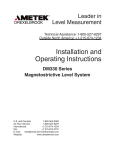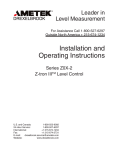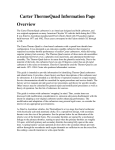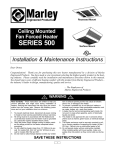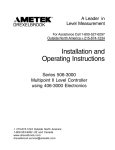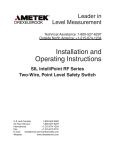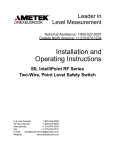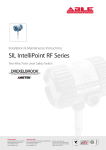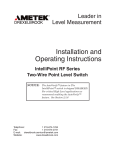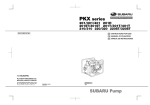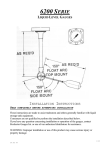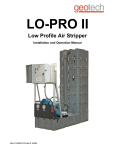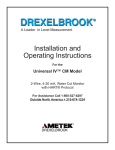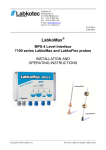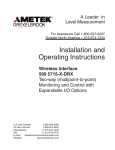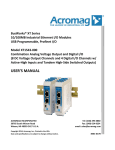Download to the PDF file.
Transcript
Leader in Level Measurement Technical Assistance: 1-800-527-6297 Outside North America: +1-215-674-1234 Installation and Operating Instructions DM3X0 Series Magnetostrictive Level System + 1-215-674-1234 Outside North America 1-800-553-9092 US and Canada www.drexelbrook.com [email protected] AMETEK Drexelbrook makes no warranty of any kind with regard to the material contained in this manual, including, but not limited to, implied warranties or fitness for a particular purpose. Drexelbrook shall not be liable for errors contained herein or for incidental or consequential damages in connection with the performance or use of material. All information contained in this manual is subject to change without notice. Copyright 2004 AMETEK Drexelbrook EDO #6-04-246 DM300-LM ISSUE #4 DM3X0 Series Magnetostrictive Level System An ISO 9001 Certified Company 205 Keith Valley Road, Horsham, PA 19044 US and Canada: 1-800-553-9092 International: +1 215-674-1234 24-Hour Service: +1 215-527-6297 Fax: +1 215-674-2731 E-mail: [email protected] Website: www.drexelbrook.com Contents Section 1: 1.1 1.2 1.3 1.4 1.5 1.6 1.7 Introduction ................................................................................................1 Product Description .....................................................................................1 Terminology .................................................................................................1 Technology...................................................................................................2 Model Number .............................................................................................3 Probe Dimensions .......................................................................................4 Sanitary Probe Dimensions .........................................................................4 Float Dimensions & Types............................................................................4 Section 2: 2.1 2.2 2.3 2.4 2.4.1 2.4.2 2.4.3 2.5 2.5.1 2.5.2 2.5.3 2.5.4 2.6 2.7 2.7.1 2.7.2 2.7.3 2.8 2.8.1 2.8.2 2.8.3 2.8.4 2.9 Installation ..................................................................................................5 Unpacking ....................................................................................................5 Mounting Conditions ...................................................................................5 Mounting Considerations .............................................................................7 Stainless Steel Probe Mounting...................................................................7 Sizing of Stainless Steel Probe....................................................................8 Assembly of Stainless Steel Probe ..............................................................9 Insertion of Stainless Steel Probe................................................................10 Flexible Polyvinylidene Fluoride (PVDF) Probe Mounting............................10 Sizing of PVDF Probe ..................................................................................11 Assembly of PVDF Probe ............................................................................12 Before Insertion of PVDF Probe ..................................................................12 Insertion of PVDF Probe..............................................................................13 Mounting Optional Housing .........................................................................14 Wiring...........................................................................................................15 Intrinsically Safe (IS) Applications...............................................................16 Intrinsically Safe Barriers .............................................................................17 Intrinsically Safe Power Supply ....................................................................17 Loop Configuration of 420mA & 20mA Control Points .................................18 Manually.......................................................................................................18 Optional Housing with Push Buttons............................................................19 Security Timing Sequence for Loop Configuration of 4mA & 20mA Control Points ..............................................19 Optional Housing with Push Buttons............................................................19 Correlating Level ..........................................................................................20 Section 3: Operation ....................................................................................................21 Section 4: 4.1 4.2 4.2.1 4.2.2 4.3 4.3.1 4.3.2 4.4 4.5 4.6 4.7 Troubleshooting .........................................................................................23 Symptom Chart............................................................................................23 Internal Diagnostics .....................................................................................23 During Normal Operation:............................................................................23 "Lost Float" Diagnostic:................................................................................23 Automatic Gain Control (AGC).....................................................................24 Manual AGC test..........................................................................................24 AGC test via Optional Housing Push buttons ..............................................24 Factory Assistance.......................................................................................25 Field Service ................................................................................................25 Customer Training ........................................................................................25 Equipment Return........................................................................................26 Section 5: Specifications.............................................................................................27 Section 6: Control Drawings .......................................................................................29 Introduction Section 1: Introduction 1.1 Product Description The AMETEK Drexelbrook DM3X0 Series Magnetostrictive Level System is an integral assembly that measures linear motion or liquid level using magnetostrictive technology. A single level output is provided with configurable 4 and 20mA points in an intrinsically safe, standard two wired loop-powered configuration. Unlike conventional level instruments the electronics are incorporated into the measuring probe and there is no external electronic housing. This design utilizes sophisticated Surface Mount Technology (SMT) integrated into a 5/8” diameter tube, reducing user's cost and offers greater options for insertion and mounting. The self-contained unit provides IP68 or Nema 4X protection in either rigid 316 stainless steel or flexible Polyvinylidene Fluoride (PVDF). There are several reasons for using a flexible PVDF probe instead of a rigid stainless steel probe: Limited Headroom: There may be limited space available above a tank, making it impossible to install a rigid probe without damaging the probe. Chemical Compatibility: When an application is not compatible with 316 SS, then PVDF may be a good alternative. Large Tanks: Since the 316 SS probe maximum length is 24 feet, PVDF can be substituted for larger tanks. PVDF probes are available in lengths up to 40 feet. Consult factory for longer lengths Other standard options include a quick disconnect miniconnector or 3⁄4” NPT conduit connection. An optional housing is available which includes terminal connectors and adjustors for zero & span. A variety of floats and mounting accessories are available to fit nearly all applications. The sanitary stainless steel version features all welded and polished construction with 180 grit for food service or 240 grit, ground, and Polished finish for more stringent sanitary applications. 1.2 Terminology Magnetostriction: A magnetic field produces small change in the physical dimension of ferromagnetic materials on the order of several parts per million in carbon steel and conversely, a physical deformation or stain (torsion) produces a change of magnetization in the material. 1 DM3X0 Series - Magnetostrictive Level System User's Manual 1.3 Technology In a magnetostrictive level sensor a current pulse is sent down a wave guide made of a special nickel alloy wire designed to enhance magnetostrictive properties. A permanent magnet within a float is used to indicate the position or level being measured. The interaction of the current pulse with the magnetic field created by a float (with magnet) produces a torsional strain pulse that travels at approximately the speed of sound along the wire. A small induction pickup coil senses the strain pulse. The position of the float is determined with high precision by measuring the time between the launching of the current pulse and the arrival of the torsional strain pulse. Because the location of the magnet on the wire during the interrogation pulse, there is no reason to “calibrate” the sensor. The magnetostrictive wire is linearized during manufacture and the speed of the torsional pulse is determined for the specific sensor. Inherently, magnetostrictive sensors have very high resolution and repeatability. Magnetostrictive technology is excellent as well for applications where the dielectric constant is very low or is changing. The technology has been used quite successfully for the detection of leaks in underground storage tanks, for example. The measurement of a 0.1 gallon leak out of a 10,000 gallon tank over a period of one hour is the standard for EPA mandated leak detection. High current (2 amp, 60 volt) interrogation pulse creates electromagnetic field along Magnetostrictive wire. Permanent Magnet in Float Reflector Magnetostrictive wire within tube... pulse t1 t2 reaction pulses Strikes field of permanent magnet & creates a torsional strain pulse or wave guide twist, "like plucking a guitar string"... ...causing two torsional strain pulses to travel in each direction along wire (the wave guide) at approximately the speed of sound. Permanent Magnet in Float Reflector Magnetostrictive wire within tube... t1 t2 t2 t1-t2 Time between initial pulse t 1 and second t 2 reflected return pulse is used to determine float position & level. Figure 1-1 Magnetostrictive Theory 2 Introduction 1.4 Model Number Magnetostrictive Level Measurement system DM300 with 4-20mA Output (No Approvals) DM330 with 4-20mA Output (FM Approved) Probe Style / Material X 316SS V PVDF (Polyvinylidene Fluoride) S 316SS 3A Sanitary 240 grit electropolished F 316SS Food Grade 180 grit Connector Style M Mini connector D Dual 3/4" NPT - for both housing and vessel mounting S Single 3/4" NPT - for housing mounting, vessel mtg. via compression fitting, flange or triclamp R Right Angle Connection Thread Mounting E English thread - 3/4" NPT with Connector Style M, D, or S Overall Length XXX (in inches only, not to exceed 600 inches) Output Signal F1 1 Signal Output Float 1 Type XXX -- see Float/Weight Kits in Chart below Housing option H Condulet with Zero & Span push-buttons X None Special Mounting C C version [limited temp. range] T TriClamp with E-clip retainer P Triclamp with CIP perm. end plug [float non-removable] W Welded Flange Fitting X None Mounting Size 20 2" Tri-clamp 25 2 1/2" Tri-clamp 30 3" Tri-clamp 40 4" Tri-clamp CF Adjustable Compression Fitting XX None Float Kits and Float / Weight Kits Float Type selection includes Float, spacer and retaining clip Material Shape Diameter Hight S.G. Max. Press. PS0 316SS Oval 1.83" 2.94" 0.61 350psi (3A Approved) PUX* Ureth. Cylind 3.85" 2.75" 0.52 50psi PNX* Nitrophyl Round 2.02" 1.38" 0.4 300psi PKX* PVDF Oval 2.05" 2.40" 0.7 100psi PEX* 316SS Oval 2.05" 2.7" 0.54 350psi XXX None YYY - Special Float / Float Kit ordered as a separate line item X* = Weight Kit 0 1 2 3 4 3 Material Shape Diameter Hight None No weight kit on Stainless Steel probes (X, S, F, or H) 316SS Round 2" 5" For PVDF Probe up to 144" long 316SS Round 2" 7" For PVDF Probe from 145" to 288" long 316SS Round 2" 11" For PVDF probe from 289" to 432" long 316SS Round 2" 13" For PVDF probe from 433" to 600" long DM3X0 Series - Magnetostrictive Level System User's Manual 1.5 Probe Dimensions - Inches (mm) M STYLE CONNECTOR [ INCHES (MM) ] OVERALL LENGTH (O.A.L.) 7/8-16 UNS-2A 1.00 (25.4) 0.625 (15.88) 8.00 (203.2) NULL ZONE 2.00 (50.8) DEAD BAND ACTIVE RANGE V STYLE CONNECTOR [PVDF VERSION] OVERALL LENGTH (O.A.L.) 3/4 NPT 2.06 (52.32) 1.6 0.625 (15.88) 3/4 NPT See Specifications for PVDF 12.00 (304.8) NULL ZONE DEAD BAND ACTIVE RANGE Sanitary Probe Dimensions - Inches (mm) (POLISHED AREA) 3.20 (81) 2.00 (51) TRI-CLAMP FITTING 7/8-16 UNS 2A 0.625 (16) 1.00 (25) 8.00 (203) NULL ZONE FLOAT FIXED END 2.94 (75) 1.75 (44) 1.83 (46) SPAN 2.00 (51) DEAD BAND OVERALL LENGTH 1.7 Float Dimensions & Types - Inches (mm) 2.05 (52) Maximum Diameter .70 (18) I.D. Style X - 316SS Probe Float Style V - PVDF Probe Float 1.35 (34) 2.69 (68) Weight "hangs" on bottom of probe Spacer keeps float in active area of probe All dimensions in inches (mm). Denotes magnet location within float Retaining Ring 4 Retaining Pin nests in recess of weight, holding it onto probe Installation Section 2: Installation IMPORTANT Be sure to read & understand all of the Installation Instructions before beginning the procedure! 2.1 Unpacking Carefully remove the contents of the shipping carton and check each item against the packing list before destroying any packing materials. If there is any shortage or damage, report to the factory at 1-215-674-1234. 2.2 Mounting Conditions CAUTION • When installing probes, do not bend rigid probes, permanent damage may result. Flexible PVDF probes are intended for coiling into a 40" (1m). Bending beyond that diameter or repeated bending can cause permanent damage. Do NOT unwind until actually feeding into vessel! Longer probes need to be supported at both ends while handling. Probes are sealed at the factory and have electronic circuits inside. Do not attempt to open probe or weld the tube. • DM3X0 Series level system is designed for industrial applications, but should be mounted in a location as free as possible from vibration, corrosive atmospheres, or any possibility of mechanical damage. • Place the level gauge in a reasonably accessible location. Ambient temperature should be between -20°F and 158°F (-4°C to 70°C). • Mount the probe perpendicular with gravity. See Figure 2-1. • Float should have free movement along probe. Float dimensions are shown in Section 1.5. • Float Retention Clip should be in place at base of probe. 5 DM3X0 Series - Magnetostrictive Level System User's Manual 2.2 Mounting Conditions (Continued) 3/4" NPT 7/8" - 16 UNS-2A Mini-connector on 316SS version 3/4" NPT Probe 5/8 Flexible PVDF Tubing 3/4" NPT Adjustable Compression Fitting Reducing Bushing Optional Flange Probe Type A B Span Range 316SS 8 in. (203) 2 in. (51) 6 to 278 in. (152 to 7061) 6 to 272 in. (152 to 6908) With Compression Fitting Span Range PVDF 12 in. (305) inches (mm) A 5/8 " Tube Variable 48 to 480 in. See Chart (1220 to 12192) Float Product Level Required PVDF Bottom Clearance Magnet Position Marked on Float Probe Length Clearance "B" to 144 in. (3658) to 288 in. (7315) to 432 in. (10973) to 480 in. (12192) 1 in. (25) 2 in. (50) 3 in. (76) 4 in. (102) 6 in. (152) 8 in. (203) 12 in. (305) 14 in. (356) Range inches (mm) On PVDF version: Allow for vessel expansion or contraction prior to tightening tube coupling Clearance Variable See Chart E-Clip Retaining B Ring & Spacer on 316SS version; may rest on bottom of vessel Bottom of Vessel Figure 2-1 Installation Diagram 6 Installation 2.3 Mounting Considerations Mounting considerations may vary (Flanges, Compression Fitting, etc.) depending on the application. For underground tanks, the probe is generally mounted in the riser, resting on the bottom of the tank. Spacers are used to hold the sensor in the riser and a cable is suspended from the tank cap. While most underground tanks are horizontal and fairly standard in design, above ground tanks vary considerably. The requirements for mounting these probes are fairly simple. Since the sensor requires a float to provide level position, there is a minimum size required for insertion of the float into the tank. It is recommended that a minimum of 2” diameter be used for the most reliable system. The size and material of the float being used will have a slight impact on the overall accuracy of the measuring system. In general, the larger the float the easier it is to provide a high accuracy measurement. 2.4 Stainless Steel Probe Mounting Null Zone 8” Overall Length Active Span 2” Deadband Figure 2-2 SS Probe up to 288" (7315mm) 7 DM3X0 Series - Magnetostrictive Level System User's Manual 2.4.1 Sizing of Stainless Steel Probe Insertion Length is: Actual length from mounting point to bottom of tank. Overall length of probe is: Insertion Length plus 2 inches (51mm) for Flange mounted probe, and Insertion Length plus 6 inches (152mm) for Compression Fitting mounted probe. If the probe rests on the bottom of the tank, then the Active Range of the probe is the Overall Length minus 10 inches (254mm) [2” (51mm) Dead Band at bottom of the probe and 8” (203mm) for the Null Zone at the top of the probe]. The amount of Active Range in a tank will vary, depending on the mounting style. Stainless Steel probes are available in lengths up to 24 feet (7.3m). Due to difficulty with shipping and installation on site, it is recommend 16 to 18 feet (4.9 to 5.4m) as maximum length for this style probe, if practical. Most of the SS Probes are mounted with probe end resting on bottom of the tank (for non pressurized tanks) or about 1⁄2” (12.7mm) from bottom (for pressurized tanks) and held in position with compression fitting at top of tank. A 5/8” x 3⁄4” adjustable fitting is used to mount probe to a flange or adapter. Minimum process connection depends on the diameter of float, but it is suggested to use 2” NPT or larger. If this compression fitting is used, fitting should be should be positioned below “crimp” in tube or a minimum of 4 inches (102mm) from the top of probe. Hand tighten fitting in a nonpressurized tank. This will allow for a slight movement of probe when tank expands or contracts. If tank is pressurized, fitting must be tightened. If a flange is being used, a “D” style connector can be specified to thread probe directly into flange. This requires more accuracy in specifying overall length of probe, but eliminates need for compression fitting or adapter bushing. Contact factory if Welded Flange connection is required. 8 Installation 2.4.2 Assembly of Stainless Steel Probe 1. Standard SS Float Kit should contain 2 inch 316 stainless steel float and retainer to hold float on to probe. There is an “E-Clip” with spacer and a ECTFE End Cap with spacer. ECTFE (Ethylene Chlorotrifluoroethylene) end cap (or foot) is used when probe is to rest on bottom of a metal tank. With either, a spacer is required to insure SS float is positioned in active area of span. 2. Two people are recommended for assembly of probe, one to hold the probe and the other to assemble components. 3. Slide compression fitting if it is being used on probe. 4. Slide reducing bushing or flange on to probe. 5. Slide float onto probe. Magnet is located in middle of the float, so orientation of float does not make any difference. 6. Slide spacer onto probe. 7. Capture all of these parts with E-Clip or ECTFE foot. At this point, if probe span is to be set outside the vessel, then go to Section 2-9 Setting Span before continuing. Mini Connector ECTFE foot or E-Clip Float 5/8” x 3⁄4” fitting 3/4” x 2” bushing Spacer 1.0" 8.0 " Span Figure 2-3 Stainless Steel Probe Assembly Sequence 9 2.0" DM3X0 Series - Magnetostrictive Level System User's Manual 2.4.3 Insertion of Stainless Steel Probe CAUTION: Do not allow float to drop suddenly since it can damage retainer at end of probe. 1. Insert bottom end of probe into tank. 2. Thread bushing into tank or flange. Bolt flange into position. 3. Thread compression fitting into bushing or flange. 4. Hand tighten. To insure compression fitting is sealed, turn fitting 1 1⁄4 turns after hand tightening. 5. Make final check to see that all of bolts and screws are in proper position and probe is securely tightened. 2.5 Flexible Polyvinylidene Fluoride (PVDF) Probe Mounting Overall Length Null Zone Null Zone 12” 12” Active Span 6+” Deadband 1-4” Clearance Figure 2-4 PVDF Probe up to 480" (12.2 m) 10 Overall Length Less PVDF expansion 3” Deadband Active Span 1” Clearance Figure 2-5 PVDF Probe version for Limited Temperature Range "C" Version Installation 2.5.1 Sizing of PVDF Probe Insertion Length: The actual height of the tank from the mounting point to the bottom of the tank. Clearance: The distance from the bottom of the tank required for probe expansion at higher temperatures. Dead Band: Inactive area at the bottom of the probe. The spacer used at the bottom of the tank to insure the float will be in the active range during contraction of the probe. Null Zone: The inactive area at the top of the probe where the electronics are located. Active Range: Is the Insertion Length minus the Clearance + Deadband plus 5” (127mm) for the Null Zone. See Table 2-1 below to determine the variable dimensions. PVDF Probes Without a Weight Kit are usually those less than 10 feet (3.1m) in length. They have a Float Kit that comes with a special spacer and pin that must be used to prevent float from entering the deadband at the end of the probe. "C" version PVDF probes are for limited temperature ranges of -4°F to 120°F (-20°C to 49°C ). They come with a spacer and upper level float collar. They have a 3" (76mm) deadband at the bottom of the probe because of less need for expansion room at those temperatures. PVDF Probes Requiring a Weight Kit, come with the weight and retainer pin along with the float made of either 316SS or PVDF, depending upon the application requirements. Deadband is variable, See Table 2-1. Null Zone Overall Length Active Span Deadband Clearance Figure 2-6 PVDF Probe Length Clearance Dead Band Null Zone Spacer 0-144 in (0 - 3660 mm) 1 in (25 mm) 6 in (152 mm) 12 in (305 mm) 5 in (127 mm) 145-288 in (368 - 7320 mm) 2 in (51 mm) 8 in (203 mm) 12 in (305 mm) 7 in (178 mm) 289-432 in (7.34 - 11 m) 3 in (76 mm) 12 in (305 mm) 12 in (305 mm) 11 in (279 mm) 433-600 in (11 - 15.2 m) 4 in (102 mm) 14 in (356 mm) 12 in (305 mm) 13 in (330 mm) Table 2-1 Variable Dimensions for PVDF Probe 11 DM3X0 Series - Magnetostrictive Level System User's Manual 2.5.2 Assembly of PVDF Probe CAUTION! Do NOT unwind coiled probe until actually feeding into vessel! Damage will occur. Assembly of a PVDF probe is almost the same as 316 SS probe, except that a weight is used for probes longer than 12 feet (3.66m) long to keep the probe perpendicular. A weight also may be needed for probes being used in agitated applications less than 12 feet in length. PVDF probes up to 16 feet (4.88m) in length are relatively rigid and shipped in the same way as 316 SS probes. PVDF probes longer than 16 feet are coiled and shipped in a box. Longer probes must be handled carefully to avoid damaging the electronics mounted within the tube. A Nylon Compression fitting and PVC reducer bushing are available for use with the PVDF probe. Limited Temperature "C" version & Retaining Collar 3/4” NPT Dual Head Nylon Compression ("C" Version) Float 5/8” x 3⁄4” fitting 3/4” x 2” bushing 10.0" (7.0" for "C" version) Spacer or Weight Kit Active Retaining Pin 5.0* * Expansion space required: Spacer length varies from 5” to 13” as probe gets longer Figure 2-7 PVDF Probe Assembly Sequence 2.5.3 Before Insertion of PVDF Probe At this point, if probe span is to be set outside the vessel, then go to Section 2-9 Setting Span before continuing... BUT READ THIS FIRST! If necessary to set the span outside of the tank, take extra precaution to avoid damaging the flexible probe. Note that the longer probes are coiled and have numbered tie wraps. If you uncoil the probe outside of the tank to set the zero and span, it is important to recoil the probe, before installation. The probe coil should be approximately 48 inches in diameter and the coils should always remain parallel with each other. If you lift a coil perpendicular to the rest of the coils, you can kink the probe. The kink generally cannot be straightened out and results in damage to the electronics in the tube. Kinking is considered user damage and is NOT covered under warranty! 12 Installation 2.5.4 Insertion of PVDF Probe Longer probes are coiled and have numbered tie wraps. When installing probe, cutting tie wraps in sequence helps to prevent the installer from accidentally twisting the probe. 1. Two people are needed, one to hold the assembled section of the probe and guide the probe into the tank, and the other to keep the coils parallel and unwrap them in sequentially. 2. Thread bushing into tank or flange. Bolt flange into position. 3. Thread compression fitting into bushing or flange. 4. Hand tighten. To insure compression fitting is sealed, turn the fitting 1 1⁄4 turns after hand tightening. Do not over tighten compression fitting if it is being used. 5. Make final check to see that all of the bolts and screws are in proper position and probe is securely tightened. A second person is recommended to support loops so they do not kink Snip tie-wraps ONLY as sensor is guided into vessel to avoid unraveling & kinking of sensor. Do NOT allow coils to separate and become perpendicular... This twist will damage the electronics within! Figure 2-8 Inserting PVDF Probe 13 DM3X0 Series - Magnetostrictive Level System User's Manual 2.6 Mounting Optional Housing Junction Box (typical) Conduit to Controller/Power Supply 3/4" NPT Adjustable Tube Coupling Reducing Bushing Optional Flange Probe Figure 2-9 Mounting Optional Housing Junction Box on Right Angle Connector Version (DM3X0X "R" Option) Figure 2-10 Housing Junction Box 14 Installation 2.7 Wiring The AMETEK Drexelbrook Magnetostrictive Level sensor uses solid state surface mount electronics within the probe itself, providing a two-wire 4-20 mA output externally powered from the loop itself. Operating voltage is from 11 to 30 Vdc. Refer to Figures 2-13, 14, & 15 for the wiring connections. CAUTION If sensor is located in a hazardous environment, do not make any electrical connections without first disconnecting electrical power at the source. Ensure that wiring connections conform to electrical codes for the specific location and hazard level. Wiring Colors Signal US EU IN + RED BROWN IN - BLACK BLACK PROGRAM WHITE BLUE CHASSIS GREEN WHITE LOOP IN (–) (Black wire) PROGRAM INPUT (White wire) LOOP (–) LOOP (+) PROGRAMMING BUTTONS CHASSIS (Sheild for Cable) (Green wire for cord set) 1 4 2 3 ZERO – + SPAN LOOP IN (+) (Red wire) Figure 2-11 "M" Probe Connector EARTH GROUND SHIELD GREEN RED BLACK WHITE From Sensor - Through Center Hub on Housing Bottom (Not Shown) Figure 2-12 "H" Housing Option 15 DM3X0 Series - Magnetostrictive Level System User's Manual 2.7 Wiring (Continued) Hazardous Area Group IIA, IIB, Zones 0, 1, or 2 (Red, + Loop) (White, Program*) (Black, - Loop) Non-Hazardous Area Safety Barrier + Loop - Loop (Shield, Earth Ground) * Reference Section 6: Control Drawings 420-0004-233-CD for installation wiring. Or, if WHITE Program wire is installed in a non-hazardous area. Transmitter Entity Parameters: Vmax = 31V Imax = 187mA Ci = 0 Li = 0uH Figure 2-13 Wiring Diagram 2.7.1 Intrinsically Safe (IS) Applications The intrinsically safe barrier must be selected with entity parameters of: Voc less than or equal to 31 V. Isc less than or equal to 187 mA. Total loop capacitance and inductance of wire should not exceed the Ca and La of barrier for the appropriate Class and Group. Use 60pF per foot and 0.2 micro H per foot for the wire, if these parameters are not known. Resistive impedance of all devices in current loop (including wire, meter, or controller, and barrier) should not exceed 500 ohms. Voltage output of the I.S. power supply should be at least 11 V at sensor after considering voltage drops across all other resistance in loop. I.S. power supply voltage should not exceed Vmax of barrier. 16 Installation 2.7.2 Intrinsically Safe Barriers Select either a single or dual channel barrier. Single channel barrier can only be used if meter (resistive load) is placed in the positive end of loop and meter has a differential input. Refer to Figure 2-16. If the meter (resistive load) must have one side connected to ground, then a dual channel barrier must be used. Refer to Figure 2-17. DM300 Figure 2-14 Single Channel Barrier DM300 Figure 2-15 Dual Channel Barrier 2.7.3 Intrinsically Safe Power Supply The I.S. power supply should have at least a 24 VDC output, and no more than 1000 feet of 16 gauge wire in the loop. 17 DM3X0 Series - Magnetostrictive Level System User's Manual 2.8 Loop Configuration of 420mA & 20mA Control Points Loop configuration of 4mA and 20mA control points can be set either outside the vessel or within the vessel. If the configuration is set inside the vessel, then actual level position within the vessel is used to set the 4mA and 20mA positions. If this is not practical, the probe should be “Bench Configured”. The system requires Intrinsically Safe power, so setting the Zero and Span points can be done in a hazardous area. 2.8.1 Manually 1.) Power-up the probe 2.) Place float at desired 4mA position 3.) Unlock the configuration program by momentarily “Shorting” the White Program Wire (Blue in EU) to the Black Loop "-" Wire (Based on the security timing sequence in Section 2.8.3) 4.) The 4mA control point is set by momentarily “Shorting” the White Program Wire (Blue in EU) to the Red Loop "+" Wire (Brown in EU) (Based on the security timing sequence in Section 2.8.3) 5.) The 20mAcontrol point is set by momentarily “Shorting” the White Program Wire (Blue in EU) to the Black Loop "-" Wire (Based on the security timing sequence in Section 2.8.3) 6.) Loop configuration is complete PROGRAMMING BUTTONS LOOP IN (–) (Black wire) PROGRAM INPUT (White wire) CHASSIS (Sheild for Cable) (Green wire for cord set) 1 4 2 3 ZERO ZERO – + SPAN SPAN LOOP IN (+) (Red wire) Figure 2-16 "M" Probe Connector Figure 2-17 "H" Housing Option 18 Installation 2.8.2 Optional Housing with Push Buttons 1.) Power-up the probe 2.) Unlock the configuration program by momentarily pressing the Span pushbutton (Based on the security timing sequence in Section 2.8.3) 3.) The 4mA is set by momentarily pressing the Zero pushbutton (Based on the security timing sequence in Section 2.8.3) 4.) The 20mA is set by momentarily pressing the Span pushbutton (Based on the security timing sequence in Section 2.8.3) 5.) Loop configuration is complete 2.8.3 Security Timing Sequence for Loop Configuration of 4mA & 20mA Control Points The Security Timing Sequence protects the DM3X0 Series from unintentional configuration (Or changes in configuration) of the 420mA & 20mA control points 1.) Unlock the configuration program by “Shorting” the White Program Wire (Blue in EU) to the Black Loop "-" Wire for three (3) seconds. See figure 2-18 for full timing sequence. 2.) Release the Short for three (3) seconds 3.) Set Zero or Span by “Shorting” either the Red Loop "+" Wire (Brown in EU) or by “Shorting” the Black Loop "-" Wire to the White Program Wire (Blue in EU) for two (2) seconds. 4.) The DM3X0 Series “Locks” the programming menu after ten (10) seconds from time of entering the program. a.) It will be necessary to enter the Security Timing Sequence twice to set both 4mA & 20mA control points 2.8.4 Optional Housing with Push Buttons 1.) Unlock the configuration program by pressing the Span pushbutton for three (3) seconds. See figure 2-18 for full timing sequence. 2.) Release the Span pushbutton for three (3) seconds 3.) Set Zero or Span by pressing either the Zero pushbutton or by pressing the Span pushbutton for two (2) seconds. 4.) The DM3X0 Series “Locks” the programming menu after ten (10) seconds from time of entering the program. a.) It will be necessary to enter the Security Timing Sequence twice to set both 4mA & 20mA control points 19 DM3X0 Series - Magnetostrictive Level System User's Manual 2.8.4 Optional Housing with Push Buttons (Continued) 0.25 Seconds Loop + 0.25 Seconds Span Open Zero Time Loop 3 Seconds T1 "Unlock" 3 Seconds T2 "Pause" Locked 2 Seconds T3 "Program" Unlocked 2 Seconds Locked Figure 2-18 Security Timomg Sequence 2.9 Correlating Level Once the Magnetostrictive Level Probe has been installed, the output may not be “accurate.” The actual level and the position of the probe in the tank need to be correlated. You might need to adjust the span to be consistent with the actual tank conditions if the span was set outside of the tank. Other than an adjustment to a reference value, there is no other "calibration" required. 20 Operation Section 3: Operation The Magnetostrictive Level System is used for accurate and repeatable measurement of linear motion and liquid level. All of the sensor’s electronics are integrated into the probe. Magnetostrictive technology uses a float with an embedded magnet that travels along the 5/8-inch diameter tube. Inside the tube is a wire that is pulsed with a current that travels down the wire. As the current pulse intersects the magnetic field of the float, a reflection creates torsion on the wire that is sensed by electronic module providing a linear 4-20 mA output. The instrument needs only to be installed and fixed in position. There are no adjustments or calibration. The sensor is a fixed length. Scaling or offset is done in the customer's process controller1. Any controller capable of accepting a 4-20 mA current loop input is suitable for use with this transmitter. 1 21 Troubleshooting Section 4: Troubleshooting 4.1 Symptom Chart Symptom Troubleshooting Tip No Signal Received at controller • Check that power is applied to controller • Check wiring connection to probe • Check process temperature [cannot exceed 230ºF (110ºC)] Output is Under 4mA • Be sure float is in place and not stuck. • Be sure float retention clip is in place at base of probe • Check automatic gain control (if output is 3.8mA) Output appears erratic • Be sure probe is mounted perpendicular with gravity • Check float for free movement along probe • Check automatic gain control Output appears to be going down, yet tank is filling • Check configuration of 4mA & 20mA points Output appears to be going up, yet tank is emptying • Check configuration of 4mA & 20mA points 4.2 Internal Diagnostics (All diagnostic values with tolerances ±0.02 mA) 4.2.1 During Normal Operation: 1. Absence of Magnet Signal, Wire Break, or float outside active range is Indicated as 3.8 mA 2. Selected Span beyond 4 mA Set Point is indicated as 3.9 mA 3. Selected Span beyond 20 mA Set Point is indicated as 20.1 mA "Lost Float" Diagnostic: When Float gets stuck beyond span or active ranges, or end cap falls off and float slips away from probe, then outputs will indicate as shown to the right. 23 Active Region Selected Span Active Region Selected Span Active Region Selected Span Active Region 3.8mA 3.8mA 3.9mA 20.1mA Selected Span 4.2.2 Figure 4-1 Built-in Diagnostics Locate Float Position DM3X0 Series - Magnetostrictive Level System User's Manual 4.3 Automatic Gain Control (AGC) (All diagnostic values with tolerances of +/- 0.02 mA) The AGC does not require any adjustment in normal operation. If the signal becomes unstable or goes to 3.8 mA with the float in the active range of the probe, check the AGC as follows: Open the probe housing in a Safe Area if application requires intrinsically safe approval. 4.3.1 Manual AGC test 1. Place float magnet near top of probe (if probe length is under 24 ft) or place the float magnet near the bottom of probe (if probe length is over 24 ft) 2. Short White (Program) wire to Black (negative Loop) wire and apply power to the probe. 3. The output will go from 12 mA to 20 mA if successful or to 3.8 mA if AGC failed. 4. Remove power from the system and remove the short (White wire to black wire). 5. Re-apply power and the system will return to normal operating mode (4-20mA) with new gain set. 6. If the system does not pass the AGC test or return to normal operation after completion of the above steps, contact the factory. 4.3.2 AGC test via Optional Housing Push buttons 1. Place float magnet near top of probe (if probe length is under 24 ft) or place the float magnet near the bottom of probe (if probe length is over 24 ft). 2. Press and hold the Zero Button and apply power to the probe. 3. The output will go from 12 mA to 20 mA if successful or to 3.8 mA if AGC failed. 4. Remove power from the system. 5. Re-apply power and the system will return to normal operating mode (4-20 mA) with new gain set. 6. If the system does not pass the AGC test or return to normal operation after completion of the above steps, contact the factory. 24 Troubleshooting 4.4 Factory Assistance AMETEK Drexelbrook can answer any questions about The DM3X0 Series instrument. Call Customer Service at 1-800-553-9092 (US and Canada) or +1 215 674-1234 (International). If you require assistance and attempts to locate the problem have failed: Contact your local Drexelbrook representative, Telephone the Service department toll-free: • 1-800-527-6297 (US and Canada) • +1 215 674-1234 (International) FAX: Service Department + 215-443-5117 E-Mail: [email protected] Please provide the following information: • • • • • • • • • 4.5 Instrument Model Number Sensing Element Model Number and Length Original Purchase Order Number Material being measured Temperature Pressure Agitation Brief description of the problem Checkout procedures that have failed Field Service Trained field servicemen are available on a time-plusexpense basis to assist in start-ups, diagnosing difficult application problems, or in-plant training of personnel. Contact the service department for further details. 4.6 Customer Training Periodically, AMETEK Drexelbrook instrument training seminars for customers are held at the factory. These sessions are guided by Drexelbrook engineers and specialists, and provide detailed information on all aspects of level measurement, including theory and practice of instrument operation. For more information write to: AMETEK Drexelbrook, Communications/ Training Group or call 215-674-1234. 25 DM3X0 Series - Magnetostrictive Level System User's Manual 4.7 Equipment Return In order to provide the best service, any equipment being returned for repair or credit must be pre-approved by the factory. In many applications, sensing elements are exposed to hazardous materials. • OSHA mandates that our employees be informed and protected from hazardous chemicals. • Material Safety Data Sheets (MSDS) listing the hazardous materials to which the sensing element has been exposed MUST accompany any repair. • It is your responsibility to fully disclose all chemicals and decontaminate the sensing element. To obtain a return authorization (RA#), contact the Service department at 1-800-527-6297 (US and Canada) or + 215-674-1234 (International). • Please provide the following information: • Model Number of Return Equipment • Serial Number • Original Purchase Order Number • Process Materials to which the equipment has been exposed. • MSDS sheets for any hazardous materials • Billing Address • Shipping Address • Purchase Order Number for Repairs • Please include a purchase order even if the repair is under warranty. If repair is covered under warranty, you will not be charged. Ship equipment freight prepaid to: AMETEK-DREXELBROOK. 205 KEITH VALLEY ROAD HORSHAM, PA 19044-1499 COD shipments will not be accepted 26 Specifications Section 5: Specifications Technology: Magnetostrictive Calibration: None Operating Voltage: 11 to 30Vdc Loop Impedance (R): 1000 ohms @ 24Volts Output: 4 to 20mA Temperature Range: -20 to 110°C (-4 to 230°F) Null zone 70°C (158°F) maximum Pressure Rating: Stainless Steel: 350psi (24 bar) float dependant PVDF (flexible): 150psi (10 bar) Resolution: 0.025% full scale or 0.02" (0.508mm) [whichever is greater] Repeatability: 0.025% full scale or 0.02" (0.508mm) [whichever is greater] Accuracy: 0.1% or 0.050" (1.27mm) [whichever is greater] Enclosure: Stainless Steel Standard NEMA 4X Epoxy painted aluminum housing (option) Probe Material: 316SS or PVDF Probe Rating: IP68 Probe Length: Stainless Steel: 20" - 288" (508mm - 7315 mm) PVDF (flexible): 20" - 480" (508mm - 12192 mm) Surface Finish: (Sanitary Probe) 180 grit 240 grit ground and polished Null Zone (Top): Stainless Steel: 8" (203 mm) PVDF (flexible): 12" (305 mm) Deadband (Bottom): Stainless Steel: 2" (51 mm) PVDF (flexible): 6" to 14" (152 mm to 356 mm) Approvals Available: II 1/2 GD EEx ia IIC T4 T90°C KEMA 01; ATEX pending 74-02 Pending 27 0344 Control Drawings THP 4-16-04 Section 6: Control Drawings 29 An ISO 9001 Certified Company 205 Keith Valley Road, Horsham, PA 19044 US and Canada: 1-800-553-9092 International: +1 215-674-1234 24-Hour Service: +1 215-527-6297 Fax: +1 215-674-2731 E-mail: [email protected] Website: www.drexelbrook.com






































